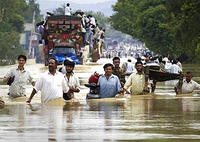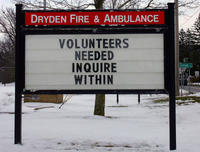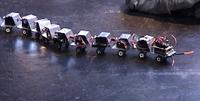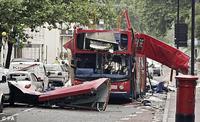-
Anytime, anywhere communications across all devices enhances collaboration

Connecticut-based company offers anytime, anywhere communications across all types of devices — allowing public safety, emergency response, and select critical infrastructure entities to communicate and collaborate in the event of an emergency; the system may also be used by the military — in the field thousands of miles away — to alert, and provide information to in real time, domestic emergency agencies
-
-
42 million displaced by natural disasters in 2010

In 2010 approximately forty-two million people were displaced from their homes due to natural disasters, more than double the number of people forced to relocate in 2009; the latest numbers were calculated by the Internal Displacement Monitoring Centre (IDMC), which found that more than 90 percent of disaster displacements were the result of weather-related events; the number of natural disasters has doubled from roughly 200 to over 400 a year during the last twenty years; the report found that countries on all continents were affected by the increase in natural disasters, but Asian countries have been hit the hardest
-
-
Connecticut addresses children's needs in disasters
Lawmakers in Connecticut recently passed legislation to help ensure the safety of children during a natural disaster or terrorist attack; on Tuesday, Connecticut’s House of Representatives approved a bill that would require the state to include the well-being of children in its emergency response plans; the bill passed 125 to 1 on Tuesday; under the law, the Commissioner of Emergency Management and Homeland Security is required to file annual reports that address the health needs of children during a biological attack or other incidents; the bill is currently on its way to Governor Dannel P. Malloy who is expected to sign it into law
-
-
Louisiana parish appoints new emergency preparedness chief
Ouachita Parish, Louisiana has ended their six-month search for a new director of Homeland Security and Emergency Preparedness just as hurricane season is about to hit; the parish’s Homeland Security Committee appointed Tracy Hilburn as the agency’s new director; the committee said that it was critical to have a new director in place before 1 June, the official start of the Atlantic Ocean’s hurricane season; as director of the parish’s Homeland Security and Emergency Preparedness agency, Hilburn will be responsible for coordinating evacuations for not only Ouachita, which is the largest parish with nearly 150,000 residents, but also the surrounding parishes
-
-
Deadly tornado kills four in Massachusetts

On Wednesday, as many as seven tornadoes tore through Massachusetts resulting in the state’s first twister related deaths in sixteen years; the tornadoes touched down in the western and central part of the state, but hit Springfield, located ninety miles west of Boston, the hardest; more than forty people have been admitted to hospitals after sustaining injuries from the tornado and four people have been confirmed dead so far; emergency responders are currently picking through the wreckage to rescue any survivors trapped in the rubble
-
-
Local emergency responders in Michigan could receive new radio system
Local emergency responders in Michigan could soon be receiving new communication equipment to connect with other nearby agencies; city councils in Grosse Pointes and Harper Woods are currently considering whether to purchase new radios to replace their aging 800 MHz system; a $485,000 DHS grant could help fund the purchase of the new radios which would cost more than $1 million to purchase
-
-
Disaster relief innovation: concrete tent

Among innovations which could help relief efforts following major disasters is a fabric shelter that, when sprayed with water, turns to concrete within twenty-four hours; the system works by impregnating cement particles into a fabric from which the tent is made; when the folded tent arrives at the disaster area, it is unrolled, tacked down with stakes, and then filled with air via a fan; once in place, the tent is soaked with water and then left to dry for twenty-four hours; once the concrete hardens, the tents can last for up to ten years; the tents come with installable doors, and since the walls are hard, electrical outlets and plumbing pipes can also be installed
-
-
Grand Junction, Colorado uses DHS grant to purchase bomb squad equipment
The Grand Junction Police Department in Colorado recently received two grants to purchase sophisticated new equipment for its bomb squad and new information sharing software; on Monday, the city council authorized the police department to accept the two grants; thanks to a $250,000 grant from DHS, the police department will now be able to purchase a Total Containment Vessel (TCV); Grand Junction also received a $108,000 grant from the Colorado Association of Chiefs of Police to purchase new software
-
-
New York firefighters receive $4.2 million to recruit volunteers

Last week the Fireman’s Association of the State of New York (FASNY) announced that it had received a $4.2 million grant from DHS to help recruit and train volunteers; the money comes as part of DHS’ Staffing for Adequate Fire and Emergency Response (SAFER) grant program; FASNY will use the grant money to launch a public awareness campaign with the goal of attracting and maintaining more than 15,000 new volunteer firefighters over the next four years; approximately 75 percent of New York’s firefighters are volunteers, but the state has struggled to attract enough people in recent years
-
-
West Virginia lottery winner donates $1 million to local police and fire departments
After winning the lottery, a West Virginia resident has donated nearly $1 million to local police and fire departments; last Thursday, W. Randy Smith purchased six Ford F-350 pickup trucks equipped with snow plows and snow blowers for six fire departments in Berkeley County; Smith says he decided to purchase the vehicles after severe winter storms last year left many emergency vehicles unable to reach their destinations; Smith’s generosity comes after winning nearly $80 million last August in the Powerball lottery; Smith has also made several other donations including new four wheel drive ambulances for the Hedgesville and Baker Heights fire departments which cost $280,000
-
-
New York first in nation to deploy PLAN emergency alert system

New Yorkers will be the first in the United States to have a new emergency alert notification system available to them; the program is called PLAN, for Personal Localized Alerting Network; PLAN is a new public safety system that allows customers who own an enabled mobile device to receive geographically targeted, text-like messages alerting them of imminent threats to safety in their area; users should expect several kinds of alerts: warnings directly from President Obama, messages about immediate safety threats, and Amber Alerts about missing kids
-
-
Students develop better security system for retailers
Northeastern University student-researchers have created technology designed to gather more meaningful information on customer habits, inventory, and fire safety in retail stores such as CVS, Stop & Shop, and The Home Depot; the students used the university library as a mock retail store; the technology they developed displays all of the information — including the location of books, computers, and fire alarms — on digitized heat maps with geographic coordinates; the system could make for a strong fire safety application
-
-
Tiltable-head robots adept at navigating disaster debris

Search and rescue missions have made the headlines in the last eighteen months, following the earthquakes in Haiti and Chile, the floods in Pakistan and New Zealand, and the tsunami in Japan; machines able to navigate through complex dirt and rubble environments could have helped rescuers after these natural disasters, but building such machines is challenging; Georgia Tech researchers have now built a robot that can penetrate and “swim” through granular material
-
-
7/7 attacks could not have been prevented: report

An inquest into the 7 July 2005 attack on London transportation concluded that any suggestion MI5 could have stopped the attacks was “based to a considerable extent on hindsight”; there were failures in the response by emergency workers — confusion, a shortage of first aid supplies, and radios that did not work underground, but the report concludes that government errors had not increased the death toll
-
-
Search-and-rescue robot operators get better with practice
Urban search and rescue (USAR) task forces are essential for locating, stabilizing, and extricating people who become trapped in confined spaces following a catastrophic event; sometimes the search area is too unstable for a live rescue team, so rescuers have turned to robots carrying video cameras; trouble is, research shows that more often than not, the human beings who remotely operate the robots have a view of their robot-control skills which is at variance with reality, causing robots to get stuck
-
- All
- Regional
- Water
- Biometrics
- Borders/Immig
- Business
- Cybersecurity
- Detection
- Disasters
- Government
- Infrastructure
- International
- Public health
- Public Safety
- Communication interoperabillity
- Emergency services
- Emergency medical services
- Fire
- First response
- IEDs
- Law Enforcement
- Law Enforcement Technology
- Military technology
- Nonlethal weapons
- Nuclear weapons
- Personal protection equipment
- Police
- Notification /alert systems
- Situational awareness
- Weapons systems
- Sci-Tech
- Sector Reports
- Surveillance
- Transportation
Advertising & Marketing: advertise@newswirepubs.com
Editorial: editor@newswirepubs.com
General: info@newswirepubs.com
2010-2011 © News Wire Publications, LLC News Wire Publications, LLC
220 Old Country Road | Suite 200 | Mineola | New York | 11501
Permissions and Policies
Editorial: editor@newswirepubs.com
General: info@newswirepubs.com
2010-2011 © News Wire Publications, LLC News Wire Publications, LLC
220 Old Country Road | Suite 200 | Mineola | New York | 11501
Permissions and Policies
